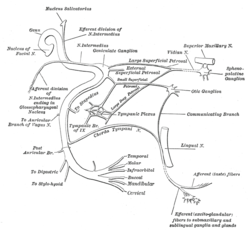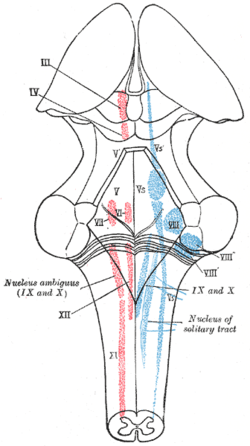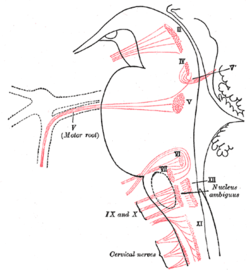Superior salivatory nucleus
| Superior salivatory nucleus | |
|---|---|
 Plan of the facial and intermediate nerves and their communication with other nerves. (Nucleus salivatorius visible at upper left.) | |
| Details | |
| Identifiers | |
| Latin | nucleus salivatorius superior |
| NeuroNames | 590 |
| NeuroLex ID | birnlex_1131 |
| TA | A14.1.05.413 |
| FMA | 72482 |
| Anatomical terms of neuroanatomy | |
The superior salivatory nucleus (or nucleus salivatorius superior) of the facial nerve is a visceromotor cranial nerve nucleus located in the pontine tegmentum. It is one of the salivatory nuclei.
Parasympathetic efferent fibers of the facial nerve (preganglionic fibers) arise according to some authors from the small cells of the facial nucleus, or according to others from a special nucleus of cells scattered in the reticular formation, dorso-medial to the facial nucleus – the superior salivatory nucleus.
Some of the preganglionic fibers travel along the greater petrosal nerve through the pterygoid canal (where they join the postsynaptic fibers of the deep petrosal nerve and are called the nerve of the pterygoid canal and synapse in the pterygopalatine ganglion, whereupon the postganglionic, postsynaptic, efferent fibers travel to innervate the lacrimal gland and the mucosal glands of the nose, palate, and pharynx.
Preganglionic parasympathetic fibers are also distributed partly via the chorda tympani and lingual nerves to the submandibular ganglion, thence by postganglionic (vasodilator) fibers to the submandibular and sublingual salivary glands.
The term "lacrimal nucleus" is sometimes used to refer to a portion of the superior salivatory nucleus.[1]
See also
Additional images
 The cranial nerve nuclei schematically represented; dorsal view. Motor nuclei in red; sensory in blue.
The cranial nerve nuclei schematically represented; dorsal view. Motor nuclei in red; sensory in blue. Nuclei of origin of cranial motor nerves schematically represented; lateral view.
Nuclei of origin of cranial motor nerves schematically represented; lateral view.
References
This article incorporates text in the public domain from page 861 of the 20th edition of Gray's Anatomy (1918)
- ↑ ancil-329 at NeuroNames